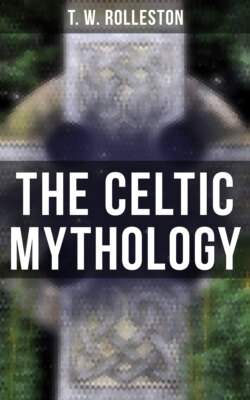Читать книгу The Celtic Mythology - T. W. Rolleston - Страница 59
На сайте Литреса книга снята с продажи.
The Names of Celtic Deities
ОглавлениеWhat were the names and the attributes of the Celtic deities? Here we are very much in the dark. The Megalithic People did not imagine their deities under concrete personal form. Stones, rivers, wells, trees, and other natural objects were to them the adequate symbols, or were half symbols, half actual embodiments, of the supernatural forces which they venerated. But the imaginative mind of the Aryan Celt was not content with this. The existence of personal gods with distinct titles and attributes is reported to us by Caesar, who equates them with various figures in the Roman pantheon—Mercury, Apollo, Mars, and so forth. Lucan mentions a triad of deities, Æsus, Teutates, and Taranus69; and it is noteworthy that in these names we seem to be in presence of a true Celtic, i.e., Aryan, tradition. Thus Æsus is derived by Belloguet from the Aryan root as, meaning “to be”, which furnished the name of Asura-masda (l'Esprit Sage) to the Persians, Æsun to the Umbrians, Asa (Divine Being) to the Scandinavians. Teutates comes from a Celtic root meaning “valiant”, “warlike”, and indicates a deity equivalent to Mars. Taranus (? Thor), according to de Jubainville, is a god of the Lightning (taran in Welsh, Cornish, and Breton is the word for “thunderbolt”). Votive inscriptions to these gods have been found in Gaul and Britain. Other inscriptions and sculptures bear testimony to the existence in Gaul of a host of minor and local deities who are mostly mere names, or not even names, to us now. In the form in which we have them these conceptions bear clear traces of Roman influence. The sculptures are rude copies of the Roman style of religious art. But we meet among them figures of much wilder and stranger aspect—gods with triple faces, gods with branching antlers on their brows, ram-headed serpents, and other now unintelligible symbols of the older faith. Very notable is the frequent occurrence of the cross-legged “Buddha” attitude so prevalent in the religious art of the East and of Mexico, and also the tendency, so well known in Egypt, to group the gods in triads.
